if you're going to do any highspeed driving, think about putting a belly pan under the engine-bay, and working on your internal aerodynamics to allow the air either out of the hood somehow, or out the sides if you are really creative. forcing a lot of air through the rad, and then under the car would produce a lot of lift...
Announcement
Collapse
No announcement yet.
V-Mount Intercoolers
Collapse
X
-
The best way to run a V-mount is with a belly pan and a vented hood. Now for those of you who aren't sure I'm not talking about a hood scoop like the WRX runs, but a cowl induction type of hood. That way you create a low pressure area behind the IC that will help to pull air through it and it vents out of the hood. But the belly pan is a good idea no matter what kind of setup you are running. Just my .02 though.
Zach
Comment
-
umm... right idea, wrong terminology. cowl induction is where they have an intake for the motor at the back of the hood, in front of the windsheild. It is a high pressure area there, so air gets forced into the intake/carb/etc... Also, since it's a high pressure area, all those people who lift the backs of their hoods aren't really accomplishing anything... but I digress...Originally posted by BoostedrexThe best way to run a V-mount is with a belly pan and a vented hood. Now for those of you who aren't sure I'm not talking about a hood scoop like the WRX runs, but a cowl induction type of hood. That way you create a low pressure area behind the IC that will help to pull air through it and it vents out of the hood. But the belly pan is a good idea no matter what kind of setup you are running. Just my .02 though.
Zach
I think what you mean is something like this, where the air is drawn out from the back of the rad or IC through a vent or louvres:
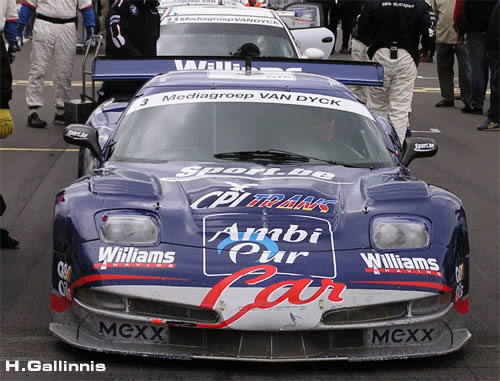
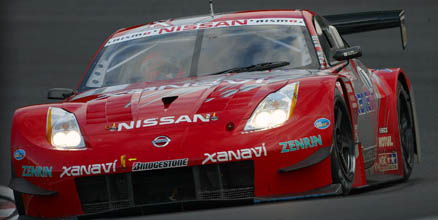
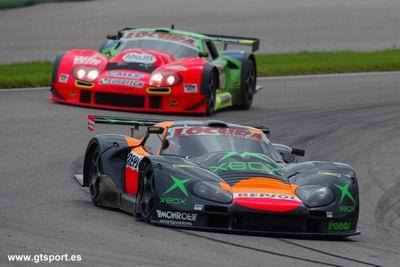
a lot of people don't realize that the front 1/3 of most hoods are actually low pressure areas, creating lift. If you do it right, you can let your air from your IC or rad outlet into that low pressure area. 1) it helps suck the air out of your IC/rad, 2) it reduces lift with no increase in drag (might actually even reduce drag too, if done properly).
Comment
-
Hi guys. New here, but i wanted to add some basics of v-mount intercoolers on daily-driven track cars... If shrouded correctly, v-mounts actually improve flow through both the radiator and intercooler. The air no longer needs to push through two vertically stacked cores- (note the fact that i haven't seen any v-mount cars with air conditioning.) The cooling system must be well designed (electric cooling fans, an air seperator tank and a functional vented hood are a must...) Probably the most valuable benefit of a v-mount setup is that the intercooler placement renders it far less prone to inevitable crash damage than with a standard FMIC...
Comment
-
I am runing a Koyo radiator and a 4in thick custom intercooler. no fans on cooler just radiator. I do live in the north west where tis a bit on the cool side. The only reason why it would over heat is cause v mounts have to have a filler neck somewhere. you will get huge air pockets if you do not have one. this will cause it to over heat. I used radiator flex hosing, and a custom filler neck. the rad does get hot, cause its bare aluminum. but the infer-red heat temp sensor i used showed that the hottest it ever got was 155 which is way below the temp it should be. The intercooler while on standstill did get a little hot where its closeset to the radiator but the rest was fine. On driving, the bottom of the radiator is ice cold while the intercooler collects condinsation from getting so cold.
just run two electric fans an you will be fine, as long as you vent the hood hot air rises remember!
here are some pics hopefully they can help you out
yes its water to air setup


trying out v mount ideas before it was a settled idea
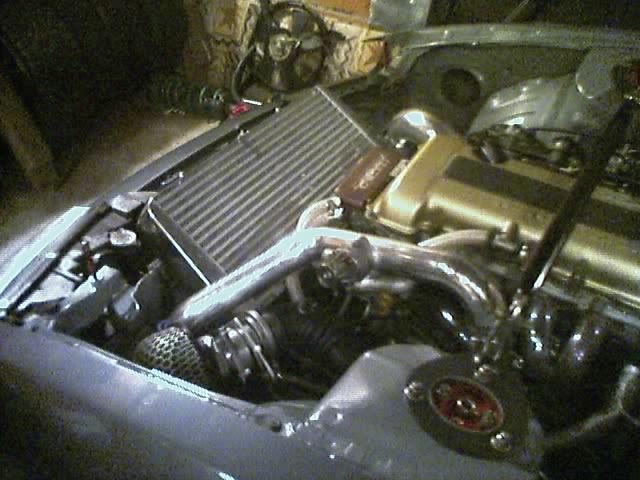
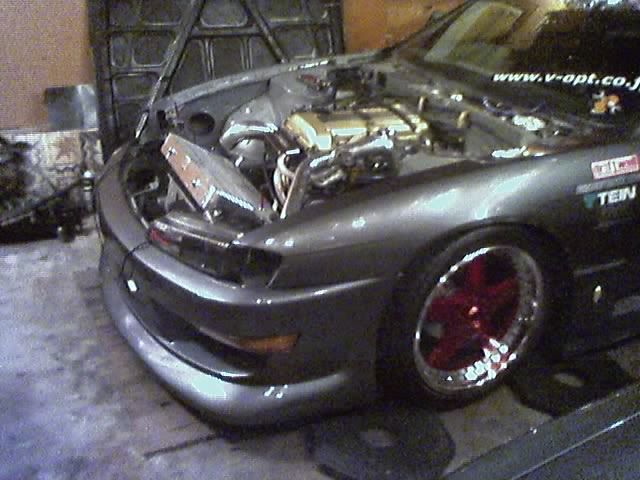
and final setup now

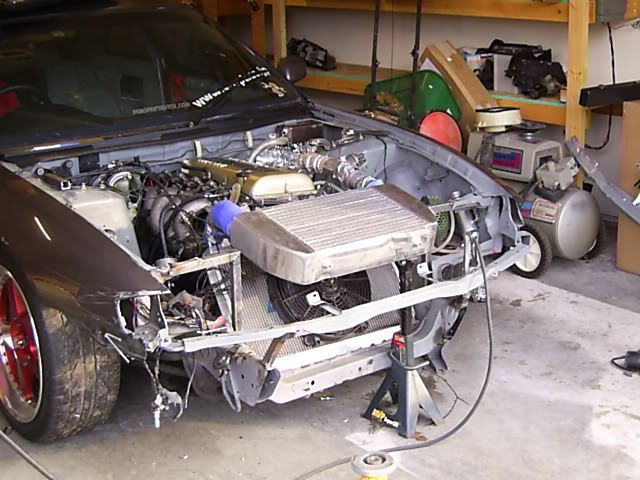
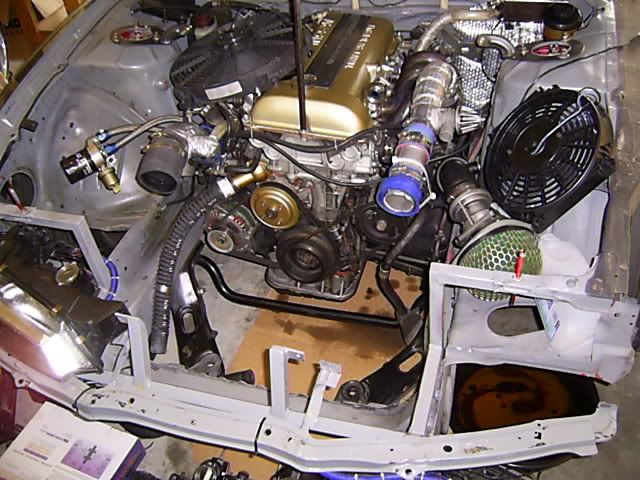


sorry for the long post, but there is hope! i had no shop help me. did it all on my own
Comment
-
I have a v-mount setup on my FC right now. Like everyone has said, you need a vented hood, as well as proper ducting to get this to work properly. Now, I'm not so sure about electric fans blocking air flow through the radiator. Pretty much every modern car uses electric fans on the radiator, I probably just don't understand what Zoltec was trying to say there.
This is mine before I cleaned everything up. If you look, I even made a cowl under the hood to keep air from going around the IC and out the hood scoop. My setup isn't the most ideal setup for cold IC temp, because air comes off of the radiator, then into the IC. MY FC has an underpan from the factory, so there was no issue there.
Sitting still, the IC does begin to heat soak, but not as bad as you think. It's fine for driving on the street. But I went to auto-x a couple weeks ago, and I had to shut the car down between run and push it to the start. After running it had, there was not enough air flowing through to cool down the IC fast enough. I hate shutting the car down like that, but the engine would get nice and warm if I didn't.
Every model car will have a different v-mount set up, depending on space. The ideal setup is having the V opening to the front of the car, so both the IC and radiator get fresh air. This was the intended purpose of the v-mount, that and the short IC piping.
I really did this as an experiment to see how hard it would be to do, and how effective this type of setup is. Obviously, I was able to put it together. It really wasn't that hard, just had to make brackets and make up some ducting. I used CF but there's no reason you can't use wood, cardboard, paper mache, etc.. As for performance, I don't have a temp gauge, so the jury is still out on that one. I'd be surprised if it out-performed the stock top mount on stock boost, but with the boost I'm running, I'm not sure the top-mount would be able to cool effectively.
Comment
-
Heres the V-mount set up that I made for my FC. I have no problems with overheating, and all i have is one electric fan on the bottom of the radiator. It cools very well at low and at high speed, and even going sideways. When i had a front mount and an aluminum radiator in the stock location, water temps would always creep up.
Comment
-
Techtrix - Nice setup.. Very interesting how you dont have overheating problems with your setup. Putting the necks on the same side defeats the purpose of the cross flow of coolant between the cooling area. Hence it's not cooling efficiently. Did you meaaure temps with a aftermarket gauge? If so, was there any temp difference compared to your previous setup? I'm very curious.
ShadowX - Your setup is backwarrds. The purpose of the v-mount is to expose the radiator and intercooler to open air. From your pics it looks like the radiator is in its stock location and the intercooler just lies in between soaking up hot air. No wonder you have heating issues.
I have an FC too. No doubt they are a major PITA to do v-mounts on without major reconfiguring.Last edited by TurboII; 06-22-2006, 09:22 PM.
Comment
-
I bought a standard radiator with the inlet and outlet in the standard locations, then i chopped and capped one, moved it to the other side, and cut a slit in the middle of the tank on the side with the inlet and outlet, and welded a plate in to block the flow of water. so now it has to go across half of the radiator, then down the tank, then back across the radiator on the lower half. its a double cross flow now, like a VW rabbit. I have a haltech E6K and the water temps never go over 200. It was a big project, i had to custom make the intercooler end tanks and piping, the radiator piping and coolant air separator tank, and all the mounts, but it was worth it, it works great.Last edited by techtrix; 06-23-2006, 09:43 AM.
Comment
-
Yes, this is my first post, and despite the fact that some people will be angry that I have disregarded common forum etiquette, I had to respond to this thread...
ets face it, most people do not have a grasp of the mechanics of a turbocharged engine.... sure people may understand the principle and basic function of a turbo, but fewer people understand "what is going on" enough to really be able to understand why someone would build a V-mount setup...
the main reason (essentially the "only" reason) for a V-mount is to reduce pressure drop and increase the spool time of your turbo.... There is no FUNCTIONAL difference between a V-mount and a top mount (like the WRX for example)... It is no surprise that the OE cars as well as race cars that use V-mount or top mount all share a common design/need: throttle response... Sporty or "rally inspired" WRX, the Nissan Pulsar, purpose built rally cars, and drift cars... throttle response is key for their operation (race car) or their driving feel (WRX uses them to make the driver feel like the car is fast and sporty and responsive... beyond their "Rally inspired" nature obviously.... this is simply a design feature for a car that is supposed to be sporty/fast/responsive from the factory)
secondly:
there have been several people commenting on how it is easy to overheat a V-mount.
let me first say: anyone who built their V-mount without electric fans on the radiator is in an idiot. we wont even discuss these idiots because they didnt use common sense or obvious logic... If we included such poor designs in this discussion, we would get no where...
Hell... if you didnt put fans on your rad in ANY situation (Regardless of orientation/design), you would never be able to drive around in traffic anyway.
with that being said:
let us imagine 2 situations... both have the same generic aftermarket larger-than-stock "koyo style" aluminum radiator. In both cases the radiator has 2 fans. in the first case, the radiator is in the normal place. at low speeds (like 20-40 mph) very very little air moves through the radiator as a result of the speed of the car (as opposed to air moved by the fans). at idle/0 mph, no air at all moves as a result of the speed of the car (ALL OF IT comes from the fans). at high speeds (40-XXX mph), lots/most (possibly all) of the air comes from the speed of the car...
now we imagine the V-mount...zero MPH (traffic/stopped): no air except the fans (just like above). medium/slow speeds: minimal air, possibly less than above... but LIKE ABOVE, most air comes from the fans... high speeds: UNLIKE ABOVE, still minimal air... much of the air probably comes from the fan...
this discussion has nothing to do with the IC, it has nothing to do with the design of the v-mount and whether or not there are ducts/dams to force the air to travel over or through the intercooler...
So... what we have shown:
at low speeds or at a stop (in traffic) a v-mount WORKS EXACTLY THE SAME as a normal radiator setup.... This is, of course, assuming we are not talking about an idiot who didnt put fans on his V-mount radiator...
with respect to heat soak/cooling of the IC: yes... the IC/piping will not cool as much, especially once the IC is "warm." this is due to the proximity of the IC to the engine, the fact that the IC gets less airflow (not matter how you design air passages), the fact that the airflow it DOES get is warm (Because it is air that is inside the engine bay and is slow moving and/or heated by the engine itself), and the fact that the piping is short (and there is less of it to radiate heat). this is a problem at sustained high RPM but low speed driving (like autocross, drifting, spirited street driving, etc)... any driving where you have your RPMs up, but you do not get very much air flow
the obvious first solution: put a fan on the intercooler like on the radiator. even a 10-20 degree difference in operating temp is huge (that would be about a 10% drop in temp)
Comment

 It's a home made setup (stock radiator with evo 8 fmic & hood cut out above the intercooler)
It's a home made setup (stock radiator with evo 8 fmic & hood cut out above the intercooler) 






Comment